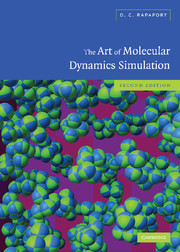Book contents
- Frontmatter
- Contents
- Preface to the first edition
- Preface to the second edition
- About the software
- 1 Introduction
- 2 Basic molecular dynamics
- 3 Simulating simple systems
- 4 Equilibrium properties of simple fluids
- 5 Dynamical properties of simple fluids
- 6 Alternative ensembles
- 7 Nonequilibrium dynamics
- 8 Rigid molecules
- 9 Flexible molecules
- 10 Geometrically constrained molecules
- 11 Internal coordinates
- 12 Many-body interactions
- 13 Long-range interactions
- 14 Step potentials
- 15 Time-dependent phenomena
- 16 Granular dynamics
- 17 Algorithms for supercomputers
- 18 More about software
- 19 The future
- Appendix
- References
- Function index
- Index
- Colophon
4 - Equilibrium properties of simple fluids
Published online by Cambridge University Press: 28 February 2011
- Frontmatter
- Contents
- Preface to the first edition
- Preface to the second edition
- About the software
- 1 Introduction
- 2 Basic molecular dynamics
- 3 Simulating simple systems
- 4 Equilibrium properties of simple fluids
- 5 Dynamical properties of simple fluids
- 6 Alternative ensembles
- 7 Nonequilibrium dynamics
- 8 Rigid molecules
- 9 Flexible molecules
- 10 Geometrically constrained molecules
- 11 Internal coordinates
- 12 Many-body interactions
- 13 Long-range interactions
- 14 Step potentials
- 15 Time-dependent phenomena
- 16 Granular dynamics
- 17 Algorithms for supercomputers
- 18 More about software
- 19 The future
- Appendix
- References
- Function index
- Index
- Colophon
Summary
Introduction
In this chapter we examine the behavior of systems in equilibrium; in particular, we focus on measurements of thermodynamic properties and studies of spatial structure and organization. The treatment of properties associated with the motion of atoms – the dynamical behavior – forms the subject of Chapter 5.
While basic MD simulation methods – formulating and solving the equations of motion – fall into a comparatively limited number of categories, a wide range of techniques is used to analyze the results. Rarely is the wealth of detail embodied in the atomic or molecular trajectories of particular interest in itself, and the issue is how to extract meaningful information from this vast body of data; even a small system of 103 structureless atoms followed over a mere 104 timesteps can produce up to 6 × 107 numbers, corresponding to a full chronological listing of the atomic coordinates and velocities. A great deal of data averaging and filtration of various kinds is required to reduce this to a manageable and meaningful level; how this is achieved depends on the questions that the simulation is supposed to answer. Much of this processing will be carried out while the simulation is in progress, but some kinds of analysis are best done subsequently, using data saved in the course of the simulation run; the choice of approach is determined by the amount of work and data involved, as well as the need for active user participation in the analysis.
- Type
- Chapter
- Information
- The Art of Molecular Dynamics Simulation , pp. 83 - 119Publisher: Cambridge University PressPrint publication year: 2004
- 1
- Cited by



